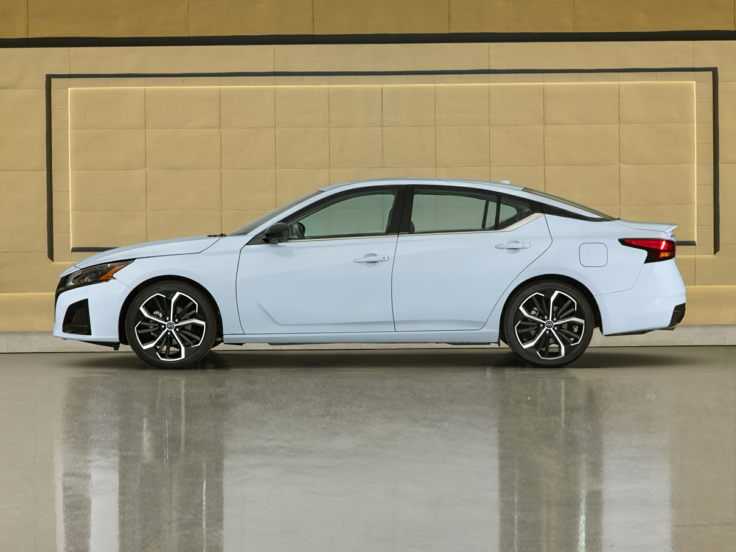Nissan ALTIMA 2023 Rear Automatic Braking (RAB) and Automatic Emergency Braking
With its Rear and Emergency Automatic Braking System, which offers a holistic approach to accident prevention, the 2023 Nissan Altima raises the bar for safety. The Rear Automatic Braking System improves parking and manoeuvring safety by using sensors and cameras to help drivers avoid collisions when reversing and automatically applying the brakes if an obstruction is detected. In the meantime, the Emergency Automatic Braking system employs cutting-edge technology to scan the road ahead and has the ability to automatically apply the brakes in order to lessen or avoid frontal crashes. Together, these features highlight the Altima’s dedication to providing safe travel for its passengers, making every trip reassuringly secure even in unforeseen traffic scenarios.
2023 Nissan Altima Specs, Price, Features and Mileage (Brochure)
REAR AUTOMATIC BRAKING (RAB)
WARNING
Failure to follow the warnings and instructions for proper use of the RAB system could result in serious injury or death.
- The RAB system is a supplemental aid to the driver. It is not a replacement for proper driving procedures. Always use the side and rear mirrors and turn and look in the direction you will move before and while backing up. Never rely solely on the RAB system. It is the driver’s responsibility to stay alert, drive safely, and be in control of the vehicle at all times.
- There is a limitation to the RAB system capability. The RAB system is not effective in all situations.
- Inclement weather or ultrasonic sources such as an automatic car wash, a truck’s compressed-air brakes or a pneumatic drill may affect the function of the system; this may include reduced performance or a false activation.
The RAB system can assist the driver when the vehicle is backing up and approaching objects directly behind the vehicle.
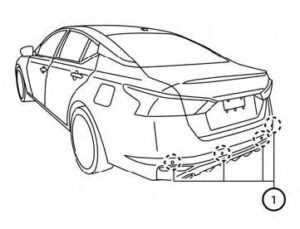
The RAB system detects obstacles behind the vehicle using the parking sensors 1O located on the rear bumper.
NOTE:
You can temporarily cancel the sonar function in the vehicle, but the RAB sys-tem will continue to operate.

RAB SYSTEM OPERATION
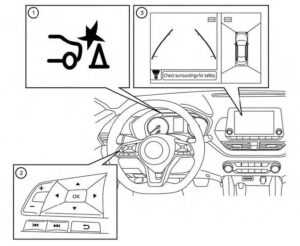
- Rear Automatic braking warning light and RAB system warning indicator
- Steering-wheel-mounted controls (left side)
- Center display
When the shift lever is in the R (Reverse) position and the vehicle speed is less than approximately 9 mph (15 km/h), the RAB system operates. If a risk of a collision with an obstacle is detected when your vehicle is backing up, the RAB system warning indicator will flash in the vehicle information display, a red frame will appear in the center display (for vehicles with the Intelligent Around View® Monitor system), and the system will chime three times. The system will then automatically apply the brakes. After the automatic brake application, the driver must depress the brake pedal to maintain brake pressure.
NOTE:
The brake lights of the vehicle come on when braking is performed by the RAB system. When the brakes operate, a noise may be heard. This is not a malfunction.
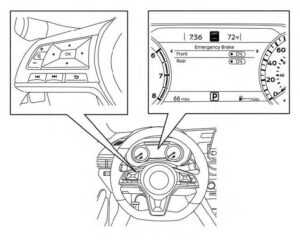
TURNING THE RAB SYSTEM ON/OFF
Perform the following steps to turn the RAB system ON or OFF. For vehicles with the 7-inch (18 cm) display.
- Press the button until “Settings” displays in the vehicle information display. Use the button to select “Driver Assistance.” Then press the OK button.
- Select “Emergency Brake” and press the OK button.
- Select “Rear” and press the OK button to turn the system on or off.

For vehicles with the 5 inch (13 cm) display.
- Press the button until “Settings” displays in the vehicle information display. Use the button to select “Driver Assistance.” Then press the OK button.
- Select “Driving Aids” and press the OK button.
- Select “Emergency Brake” and press the OK button.
- Select “Rear” and press the OK button to turn the system on or off. When the RAB system is turned off, the rear automatic braking warning light Nissan illuminates.
NOTE:
The RAB system will be automatically turned on when the engine is restarted.
RAB SYSTEM LIMITATIONS
Listed below are the system limitations for the RAB system. Failure to follow the warnings and instructions for proper use of the RAB system could result in serious injury or death.
- Listed below are the system limitations for the RAB system. Failure to follow the warnings and instructions for proper use of the RAB system could result in serious injury or death. When the vehicle approaches an obstacle while the accelerator or brake pedal is depressed, the function may not operate or the start of operation may be delayed. The RAB system may not operate or may not perform sufficiently due to vehicle conditions, driving conditions, the traffic environment, the weather, road surface conditions, etc. Do not wait for the system to operate. Operate the brake pedal by yourself as soon as necessary.\ If it is necessary to override RAB operation, strongly press the accelerator pedal. Always check your surroundings and turn to check what is behind you before and while backing up.
- The RAB system detects stationary objects behind the vehicle. The RAB system does not detect the following objects:
- Moving objects
- Low objects
- Narrow objects
- Wedge-shaped objects
- Objects close to the bumper (less than approximately 1 ft [30 cm])
- Objects that suddenly appear
- Thin objects such as rope, wire, chain, etc.
- The RAB system may not operate for the following obstacles:
- Obstacles located high off the ground
- Obstacles in a position offset from your vehicle
- Obstacles, such as spongy materials or snow, that have soft outer surfaces and can easily absorb a sound wave
- The RAB system may not operate in the following conditions:
- There is rain, snow, ice, dirt, etc., attached to the sonar sensors.
- A loud sound is heard in the area around the vehicle.
- The surface of the obstacle is diagonal to the rear of the vehicle.
- The RAB system may unintentionally operate in the following conditions:
- There is overgrown grass in the area around the vehicle.
- There is a structure (e.g., a wall, toll gate equipment, a narrow tunnel, a parking lot gate) near the side of the vehicle.
- There are bumps, protrusions, or manhole covers on the road surface.
- The vehicle drives through a draped flag or a curtain.
- There is an accumulation of snow or ice behind the vehicle.
- An ultrasonic wave source, such as another vehicle’s sonar, is near the vehicle.
- Once the automatic brake control operates, it does not operate again if the vehicle approaches the same obstacle.
- The automatic brake control can only operate for a short period of time. Therefore, the driver must depress the brake pedal.
- In the following situations, the RAB system may not operate properly or may not function sufficiently:
- The vehicle is driven in bad weather (rain, fog, snow, etc.).
- The vehicle is driven on a steep hill.
- The vehicle’s posture is changed (e.g., when driving over a bump).
- The vehicle is driven on a slippery road.
- The vehicle is turned sharply by turning the steering wheel fully.
- Snow chains are used.
- Wheels or tires other than NISSAN recommended are used.
- The brakes are cold at low ambient temperatures or immediately after driving has started.
- The braking force becomes poor due to wet brakes after driving through a puddle or washing the vehicle.
- Turn the RAB system off in the following conditions to prevent the occurrence of an unexpected accident resulting from sudden system operation:
- The vehicle is towed.
- The vehicle is carried on a flatbed truck.
- The vehicle is on the chassis dynamometer.
- The vehicle drives on an uneven road surface.
- The vehicle is towing an object (if so equipped).
- Suspension parts other than those designated as Genuine NISSAN parts are used. (If the vehicle height or the vehicle body inclination is changed, the system may not detect an obstacle correctly.)
- If the vehicle is using an accessory like a bike rack, or cargo carrier that blocks the sensors.
- Excessive noise (e.g., audio system volume, an open vehicle window) will interfere with the chime sound, and it may not be heard.
SYSTEM MALFUNCTION
If Rear automatic braking warning light nissan malfunctions, it will be turned off automatically, the RAB system warning light will illuminate, and the “Mal-function: See Owner’s Manual” warning message will appear in the vehicle information display and a chime will sound.
Action to take
If the warning light illuminates, park the vehicle in a safe location, turn the engine off, and restart the engine. If the warning light continues to illuminate, have the RAB system checked. It is recommended that you visit a NISSAN dealer for this service.
NOTE:
If the RAB system cannot be operated temporarily, the RAB system warning light blinks.
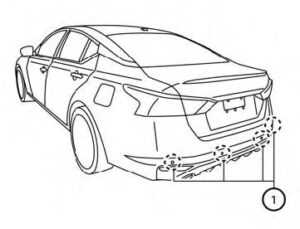
SYSTEM MAINTENANCE
Observe the following items to ensure proper operation of the system:
- Always keep the parking sensors 1O clean.
- If the parking sensors are dirty, wipe them off with a soft cloth while being careful to not damage them.
- Do not subject the area around the parking sensors 1O to strong impact. Also, do not remove or disassemble the parking sensors. If the parking sensors and peripheral areas are deformed in an accident, etc., have the sensors checked. It is recommended that you visit a NISSAN dealer for this service.
- Do not install any stickers (including transparent stickers) or accessories on the parking sensors 1O and their surrounding areas. This may cause a malfunction or improper operation.
AUTOMATIC EMERGENCY BRAKING (AEB) WITH PEDESTRIAN DETECTION
WARNING
Failure to follow the warnings and instructions for proper use of the AEB with the Pedestrian Detection system could result in serious injury or death. The AEB with Pedestrian Detection system is a supplemental aid to the driver. It is not a replacement for the driver’s attention to traffic conditions or responsibility to drive safely. It cannot prevent accidents due to carelessness or dangerous driving techniques. The AEB with Pedestrian Detection system does not function in all driving, traffic, weather and road conditions. The AEB with Pedestrian Detection system can assist the driver when there is a risk of a forward collision with the vehicle ahead in the traveling lane or with a pedestrian ahead in the traveling lane.

The AEB with Pedestrian Detection system uses a radar sensor located on the front of the vehicle OB to measure the distance to the vehicle ahead in the same lane. For pedestrians, the AEB with Pedestrian Detection system uses a camera installed behind the windshield OA in addition to the radar sensor.
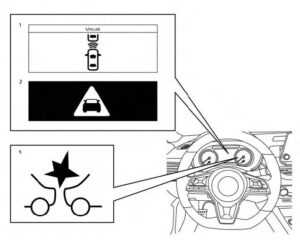
AEB WITH PEDESTRIAN DETECTION SYSTEM OPERATION
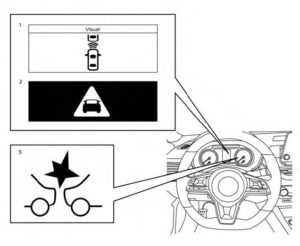
For vehicles with the 5 inch (13 cm) display
- The vehicle ahead detection indicator
- AEB with Pedestrian Detection emergency warning indicator
- AEB with Pedestrian Detection system warning light
The AEB system operates at speeds above approximately 3 mph (5 km/h). For the pedestrian detection function, the system operates at speeds between 6–37mph (10 – 60 km/h).
If a risk of a forward collision is detected, the AEB with Pedestrian Detection system will first provide the warning to the driver by flashing the vehicle ahead detection indicator (yellow) in the vehicle information display and providing an audible alert. If the driver applies the brakes quickly and forcefully after the warning, and the AEB with Pedestrian Detection system detects that there is still the possibility of a forward collision, the system will automatically increase the braking force.
If the driver does not take action, the AEB with Pedestrian Detection system issues the second visual (2) (flashing) (red and white) and audible warning. If the driver releases the accelerator pedal, then the system applies partial braking. If the risk of a collision becomes imminent, the AEB with Pedestrian Detection system applies harder braking automatically. While the AEB with Pedestrian Detection system is operating, you may hear the sound of brake operation. This is normal and indicates that the AEB with Pedestrian Detection system is operating properly.
NOTE:
The vehicle’s brake lights come on when any braking is performed by the AEB with the Pedestrian Detection system. Depending on vehicle speed and distance to the vehicle or pedestrian ahead, as well as driving and roadway conditions, the sys-tem may help the driver avoid a forward collision or may help mitigate the consequences if a collision should be unavoidable. If the driver is handling the steering wheel, accelerating or braking, the AEB with Pedestrian Detection system will function later or will not function.
The rear automatic braking malfunction Nissan Altima will cease under the following conditions:
- When the steering wheel is turned to avoid a collision.
- When the accelerator pedal is depressed.
- When there is no longer a vehicle or a pedestrian detected ahead.
If the AEB with Pedestrian Detection sys-tem has stopped the vehicle, the vehicle will remain at a standstill for approximately 2 seconds before the brakes are released.
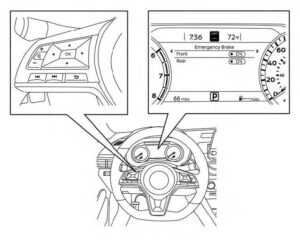
TURNING THE AEB WITH PEDESTRIAN DETECTION SYSTEM ON/OF
Perform the following steps to enable or disable the AEB with the Pedestrian Detection system. For vehicles with a 7-inch (18 cm) display.
- Press the button until “Settings” displays in the vehicle information display. Use the button to select “Driver Assistance.” Then press the OK button.
- Select “Emergency Brake” and press the OK button.
- Select “Front” and press the OK button to turn the system on or off.
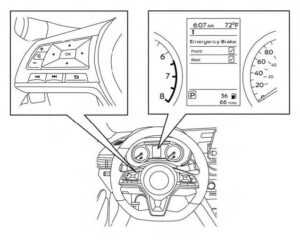
For vehicles with the 5-inch (13 cm) display.
- Press the button until “Settings” displays in the vehicle information display. Use the button to select “Driver Assistance.” Then press the OK button.
- Select “Driving Aids” and press the OK button.
- Select “Emergency Brake” and press the OK button.
- Select “Front” and press the OK button to turn the system on or off.
When the AEB with Pedestrian Detection system is turned off, the AEB with Pedestrian Detection system warning light illuminates.
NOTE:
- The AEB with Pedestrian Detection system will be automatically turned on when the engine is restarted.
- The I-FCW system is integrated into the AEB with the Pedestrian Detection system. There is not separate selection in the vehicle information display for the
I- FCW system. When the AEB system is turned off, the I-FCW system is also turned off. - Disabling the Vehicle Dynamic Control (VDC) system causes the AEB with the Pedestrian Detection system to become unavailable regardless of the settings selected in the vehicle information display.
The Nissan rogue AEB warning light typically refers to the “Automatic Emergency Braking” system. If this light is illuminated, it indicates a potential issue or malfunction with the automatic emergency braking system, and it should be inspected and repaired by a qualified technician.
AEB WITH PEDESTRIAN DETECTION SYSTEM LIMITATIONS
WARNING
Listed below are the system limitations for the AEB with Pedestrian Detection system. Failure to operate the vehicle in accordance with these system limitations could result in serious injury or death.
- The AEB with Pedestrian Detection system cannot detect all vehicles or pedestrians under all conditions.
- The AEB with Pedestrian Detection system does not detect the following:
- Pedestrians that are small (for example, children), in a sitting position, operating toys/skateboards, on scooters or in wheelchairs, or not in an upright standing or walking position.
- Animals of any size.
- Obstacles (for example, cargo or debris) on the roadway or roadside.
- Oncoming or crossing vehicles.
- Vehicles where the tires are difficult to see or the shape of the rear of the vehicle is unclear or obstructed.
- Parked vehicles.
- The AEB with Pedestrian Detection system has some performance limitations.
- If a stationary vehicle is in the vehi-cle’s path, the system will not function when the vehicle approaches the stationary vehicle at speeds over approximately 50 mph (80 km/h).
- Pedestrian detection will not function when the vehicle is driven at speeds over approximately 37 mph (60 km/h) or below approximately 6 mph (10km/h).
- For pedestrians, the AEB with Pedestrian Detection system will not issue the first warning.
- The AEB with Pedestrian Detection system may not function properly or detect a vehicle or pedestrians ahead in the following conditions:
- In poor visibility conditions (such as rain, snow, fog, dust storms, sand storms, smoke, and road spray from other vehicles).
- If dirt, ice, snow, fog or other material is covering the radar sensor area or camera area of the windshield.
- If strong light (for example, sunlight or high beams) enters the front camera or a sudden change in brightness occurs (for example, entering a tunnel or driving in lightning).
- In dark or dimly lit conditions, such as at night or in tunnels, including cases where your vehi-cle’s headlights are off or dim, or the tail lights of the vehicle ahead are off.
- When the direction of the camera is misaligned.
- When driving on a steep downhill slope, on roads with sharp curves, and/or bumpy or dirt roads.
- If there is interference by other radar sources.
- When your vehicle’s position or movement is changed quickly or significantly (for example, lane change, turning vehicle, abrupt steering, sudden acceleration or deceleration).
- When your vehicle or the vehicle or pedestrian ahead moves quickly or significantly such that the system cannot detect and react in time (for example, pedestrian moving quickly toward the vehicle at close range, vehicle cutting in, changing lanes, making a turn, steering abruptly, sudden acceleration or deceleration).
- When the vehicle or pedestrian is offset from the vehicle’s forward path.
- If the speed difference between the two vehicles is small.
- The pedestrian’s profile is partially obscured or unidentifiable; for example, due to transporting luggage, pushing a stroller, wearing bulky or very loose-fitting clothing or accessories, or being in a unique posture (such as raising hands).
- There is poor contrast of a person to the background, such as having clothing color or pattern that is similar to the background.
- For approximately 15 seconds after starting the engine.
- If the vehicle ahead has a unique or unusual shape, extremely low or high clearance heights, or un-usual cargo loading or is narrow (for example, a motorcycle).
- When the vehicle or pedestrian is located near a traffic sign, a reflective area (for example, water on the road), or is in a shadow.
- When multiple pedestrians are grouped together.
- When the view of the pedestrian is obscured by a vehicle or other object.
- The system performance may be degraded in the following conditions:
- The vehicle is driven on a slippery road.
- The vehicle is driven on a slope.
- Excessively heavy baggage is loaded in the rear seat or the cargo area of your vehicle.
- The system is designed to automatically check the sensor’s (radar and camera) functionality, within certain limitations. The system may not detect some forms of obstruction of the sensor area such as ice, snow or stickers, for example. In these cases, the system may not be able to warn the driver properly. Be sure that you check, clean, and clear sensor areas regularly.
- In some road and traffic conditions, the AEB with Pedestrian Detection system may unexpectedly apply partial braking. When acceleration is necessary, depress the accelerator pedal to override the system.
- The AEB with Pedestrian Detection system may operate when a pattern, object, shadow or lights are detected that are similar to the outline of vehicles or pedestrians, or if they are the same size and position as a vehicle or motorcycle’s tail lights.
- The system may keep operating when the vehicle ahead is turning right or left.
- The system may operate when your vehicle is approaching and passing a vehicle ahead.
- Depending on the road shape (curved road, entrance and exit of the curve, winding road, lane regulation, under construction, etc.), the system may operate temporarily for the oncoming vehicle in front of your vehicle.

WARNING
Listed below are the system limitations for the AEB with Pedestrian Detection system. Failure to operate the vehicle in accordance with these system limitations could result in serious injury or death.
- The AEB with Pedestrian Detection system may react to:
- objects on the roadside (traffic sign, guardrail, pedestrian, motorcycle, vehicle, etc.)
- pedestrians when driving on narrow alleys, etc.
- pedestrians who temporarily protrude into or approach the driving lane to avoid the obstacles on the road shoulder
- objects above road (low bridge, traffic sign, etc.)
- objects on the road surface (rail-road track, grate, steel plate, etc.)
- objects in the parking garage (beam, pillar, etc.)
- pedestrians or motorcycles approaching the traveling lane
- vehicles, pedestrians, motorcycles or objects in adjacent lanes or close to the vehicle
- oncoming pedestrians
- 0bjects on the road (such as trees)
- Braking distances increase on slippery surfaces.
- Excessive noise will interfere with the warning chime sound, and the chime may not be heard.

SYSTEM TEMPORARILY UNAVAILABLE
Condition A:
In the following conditions, the AEB with Pedestrian Detection system warning light blinks, and the system will be turned off automatically:
- The camera area of the windshield is misted or frozen.
- Strong light is shining from the front.
- The cabin temperature is over approximately 104°F (40°C) in direct sunlight.
- The camera area of the windshield glass is continuously covered with dirt, etc.
Action to take
When the above conditions no longer exist, the AEB with the Pedestrian Detection system will resume automatically.
NOTE:
When the inside of the windshield on the camera area is misted or frozen, it will take a period of time to remove it after the A/C turns on. If dirt appears on this area, it is recommended that you visit a NISSAN dealer.
In the following conditions, the AEB with Pedestrian Detection system warning light illuminates and the system will be turned off automatically:
- The radar sensor picks up interference from another radar source.
Action to take
When the above conditions no longer exist, the AEB with the Pedestrian Detection system will resume automatically.
Condition B:
When there is inclement weather (rain, fog, snow, etc.) blocking the front radar sensor, the AEB with Pedestrian Detection system will be canceled, and the “Forward Driving Aids temporarily disabled Front Sensor blocked See Owner’s Manual” warning message will appear in the vehicle information display. The AEB with Pedestrian Detection system warning light (yellow) will illuminate.
Action to take:
When the conditions listed above are no longer present, the warning message will no longer be available in the vehicle information display. If the “Forward Driving Aids temporarily disabled Front Sensor blocked See Owner’s Manual” warning message continues to be displayed, have the system checked. It is recommended that you visit a NISSAN dealer for this service.
Condition C:
When the radar sensor of the front bumper is covered with dirt or is obstructed, the AEB with Pedestrian Detection system will automatically be canceled. The “Forward Driving Aids temporarily disabled Front Sensor blocked See Owner’s Manual” warning message will appear in the vehicle information display. The AEB with Pedestrian Detection system warning light (yellow) will illuminate.
Action to take:
If the warning message appears, stop the vehicle in a safe place, place the shift lever in the P (Park) position, and turn the engine off. When the radar signal is temporarily interrupted, clean the sensor area of the front bumper and restart the engine. If the “Forward Driving Aids temporarily disabled Front Sensor blocked See Owner’s Manual” warning message continues to be displayed, have the system checked. It is recommended that you visit a NISSAN dealer for this service.
Condition D
When driving on roads with limited road structures or buildings (for example, long bridges, deserts, snowfields, driving next to long walls), the system may illuminate the system warning light and display the “For-ward Driving Aids Temporarily Disabled Front Sensor Blocked See Owner’s Manual” message.
Action to take:
When the above driving conditions no longer exist, turn the system back on.
Condition E
When the Vehicle Dynamic Control (VDC) system is turned off, the AEB with Pedestrian Detection system braking will not operate. In this case, only the visible and audible warning operates. The AEB with Pedestrian Detection system warning light (yellow) will illuminate.
Action to take:
When the VDC system is on, the AEB with the Pedestrian Detection system will resume automatically.
NOTE:
If the AEB with Pedestrian Detection system stops working, the I-FCW system will also stop working.
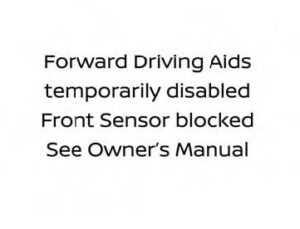
SYSTEM MALFUNCTION
If the AEB with Pedestrian Detection system malfunctions, it will be turned off automatically, a chime will sound, the AEB with Pedestrian Detection system warning light (yellow) will illuminate and the warning message [Malfunction] will appear in the vehicle information display.
Action to take
If the warning light (yellow) comes on, stop the vehicle in a safe location, turn the engine off, and restart the engine. If the warning light continues to illuminate, have the AEB with the Pedestrian Detection system checked. It is recommended that you visit a NISSAN dealer for this service.
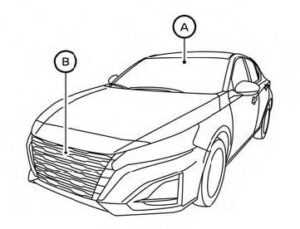
SYSTEM MAINTENANCE
The radar sensor is located on the front of the vehicle OB. The camera is located on the upper side of the windshield OA.
To keep the AEB with Pedestrian Detection system operating properly, be sure to observe the following:
- Always keep the sensor areas of the front bumper and windshield clean.
- Do not strike or damage the areas around the sensors (e.g., bumper, windshield).
- Do not cover or attach stickers, or install any accessory near the sensors. This could block sensor signals and/or cause failure or malfunction.
Do not attach metallic objects near the radar sensor (brush guard, etc.). This could cause failure or malfunction. - Do not place reflective materials, such as white paper or a mirror, on the instrument panel. The reflection of sunlight may adversely affect the camera unit’s detection capability.
- Do not alter, remove or paint the front bumper. Before customizing or restoring the front bumper, it is recommended that you visit a NISSAN dealer.
Radiofrequency statement
For USA
FCC ID OAYARS4B
This device complies with Part 15 of the FCC Rules.
Operation is subject to the following two conditions:
- This device may not cause harmful interference, and
- This device must accept any interference received, including interference that may cause undesired operation.
FCC Warning
Changes or modifications not expressly approved by the party responsible for compliance could void the user’s authority to operate the equipment.
- For Canada
- Model: ARS4–B
- IC: 4135A-ARS4B
- FCC ID: OAYARS4B
This device complies with Part 15 of the FCC Rules and with Industry Canada license-exempt RSS standard(s). Operation is subject to the following two conditions:
- This device may not cause interference, and
- This device must accept any interference received, including interference that may cause undesired operation of the device.
FAQ
The Rear Automatic Braking System is a safety feature in the 2023 Altima that helps prevent collisions when reversing by automatically applying the brakes if an obstacle is detected.
The system uses sensors and cameras to monitor the area behind the vehicle. If it detects an obstacle while reversing, it can automatically apply the brakes to avoid a collision.
Many vehicles with this system allow the driver to enable or disable it through the vehicle’s settings menu.
This system is primarily designed to operate at low speeds, typically when the vehicle is in reverse.
Emergency Automatic Braking, also known as Forward Emergency Braking, is a safety feature that can automatically apply the brakes to prevent or mitigate a frontal collision.
Emergency Automatic Braking uses sensors, cameras, or radar to monitor the road ahead. If it detects an imminent collision and the driver doesn’t respond in time, it can apply the brakes to reduce the severity of the impact or avoid it altogether.
The driver can typically override Emergency Automatic Braking by applying the brakes or taking control of the vehicle.
The availability of Emergency Automatic Braking may vary by trim level and options, so it’s advisable to check the specific features offered in your chosen trim.
Some vehicles allow you to adjust the sensitivity or warning thresholds of the system through the vehicle’s settings menu.
Emergency Automatic Braking is designed to work in a variety of driving conditions, but its performance may be affected by factors like weather and road conditions.
Vehicles equipped with Emergency Automatic Braking often include additional safety features such as pedestrian detection, blind-spot monitoring, and lane-keeping assistance.
The two systems typically operate independently, with Rear Automatic Braking focused on preventing rear-end collisions when reversing, while Emergency Automatic Braking addresses frontal collisions while driving forward.
The system may offer customization options, such as adjusting the sensitivity or turning it on or off, depending on the vehicle’s configuration.
The Rear Automatic Braking System helps drivers avoid collisions with obstacles, pedestrians, or other vehicles while maneuvering in parking lots or tight spaces, adding an extra layer of safety during parking.
Many vehicles equipped with Rear Automatic Braking also feature a rearview camera that provides a visual display of the area behind the vehicle, aiding in parking and maneuvering.
Useful Link
View Full User Guide: Nissan ALTIMA 2023 User Guide
Download Manuals: https://www.nissanusa.com/owners/ownership/manuals-guides.html
2023 Nissan Altima Specs, Price, Features and Mileage (Brochure)

